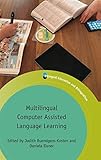Multilingual Computer Assisted Language Learning / ed. by Judith Buendgens-Kosten, Daniela Elsner.
Material type: TextSeries: Bilingual Education & BilingualismPublisher: Bristol ; Blue Ridge Summit : Multilingual Matters, [2018]Copyright date: ©2018Description: 1 online resourceContent type:
TextSeries: Bilingual Education & BilingualismPublisher: Bristol ; Blue Ridge Summit : Multilingual Matters, [2018]Copyright date: ©2018Description: 1 online resourceContent type: - 9781788921480
- 9781788921497
- EDUCATION / Computers & Technology
- CALL
- MCALL
- Plurilingualism
- SLA
- computer-assisted language learning
- digital language learning and teaching
- language learning and computer games
- language teaching with computers
- language teaching with technology
- multilingualism
- multiliteracies
- technology in the classroom
- 418.00285 23
- online - DeGruyter
- Issued also in print.
| Item type | Current library | Call number | URL | Status | Notes | Barcode | |
|---|---|---|---|---|---|---|---|
 eBook
eBook
|
Biblioteca "Angelicum" Pont. Univ. S.Tommaso d'Aquino Nuvola online | online - DeGruyter (Browse shelf(Opens below)) | Online access | Not for loan (Accesso limitato) | Accesso per gli utenti autorizzati / Access for authorized users | (dgr)9781788921497 |
Frontmatter -- Contents -- Contributors -- Multilingual CALL: Introduction -- Part 1: Multiliteracies and MCALL -- 1. The Multiple Languages of Digital Communication -- 2. Learnscaping: Creating Next-Gen Learning Environments for Pluriliteracies Growth -- Part 2: Multilingual Texts -- 3. 'I like the character, weil er so richtig funny ist': Reading Story Apps in the Primary EFL Classroom -- 4. Awareness of Multilingual Resources: EFL Primary Students' Receptive Code-Switching during Collaborative Reading -- 5. This is How I Say It! Discourse with Tablets among Multilingual Learners -- 6. Über die Grenzen des einsprachigen Habitus: Application of Computer Assisted Language Learning through Home Language Content in Secondary Level Classrooms -- 7. Playful Plurilingualism? Exploring Language(s) with the Multilingual Serious Game MElang-E -- Part 3: Intercomprehension and CALL -- 8. (A) CALL for Slavic Intercomprehension: The Promotion of Minority Languages in the Modern Foreign Language Classroom -- 9. When Non-Romance Languages Break the Linguistic Contract in Romance Languages Chat Rooms: Theoretical Consequences for Studies on Intercomprehension -- Part 4: Multilingual Online Exchange and Telecollaboration -- 10. Developing Plurilingual Competence in the EFL Primary Classroom through Telecollaboration -- 11. Advanced Language Learners as Autonomous Language Users on Facebook -- Part 5: MCALL and Professional Development of Teachers -- 12. Multilingual Digital Translanguaging and Storying with New Zealand Pasifi ka Learners -- Learning in Multilingually and Digitally Mediated Spaces: The MCALL Approach -- Index
restricted access online access with authorization star
http://purl.org/coar/access_right/c_16ec
Recent developments in education, such as the increasing linguistic diversity in school populations and the digital revolution which has led to new ways of being, learning and socialising, have brought about fresh challenges and opportunities. In response, this book shows how technology enriches multilingual language learning, as well as how multilingual practices enrich computer assisted language learning (CALL) by bringing together two, thus far distinct, fields of research: CALL and multilingual approaches to language learning. The collection includes contributions from researchers and practitioners from three continents to illustrate how native languages, previously studied languages, heritage languages or dialects are activated through technology in formal and informal learning situations. The studies in this book showcase multilingual language use in chat rooms, computer games, digital stories, ebook apps, online texts and telecollaboration/virtual exchange via interactive whiteboards. This volume will be of interest to researchers interested in language learning and teaching and to practitioners looking for support in seizing the opportunities presented by the multilingual, digital classroom.
Issued also in print.
Mode of access: Internet via World Wide Web.
In English.
Description based on online resource; title from PDF title page (publisher's Web site, viewed 24. Apr 2022)


